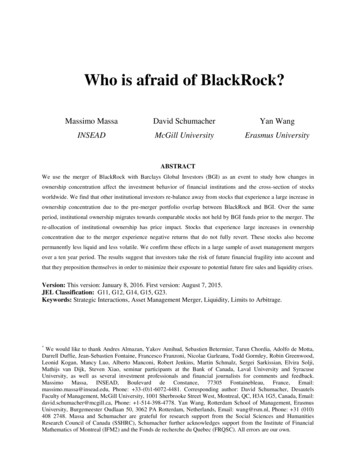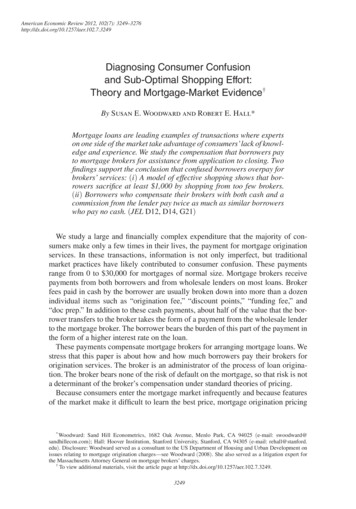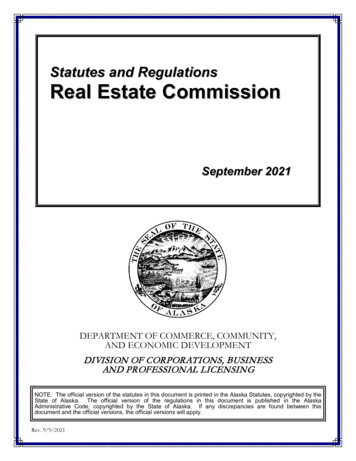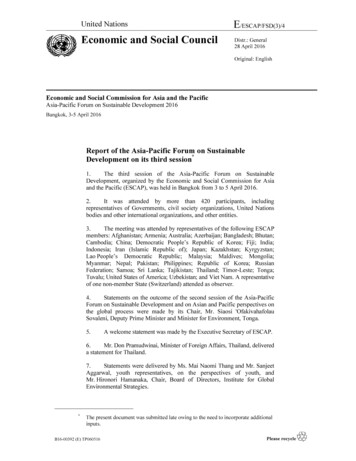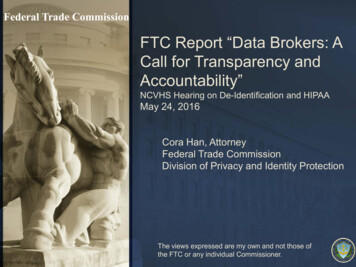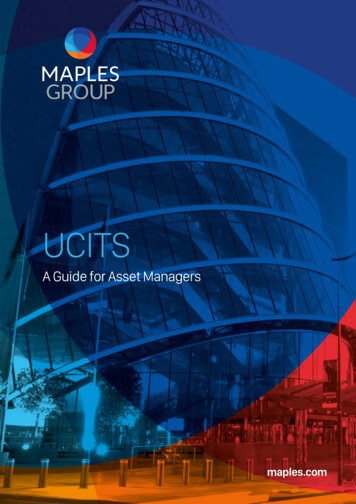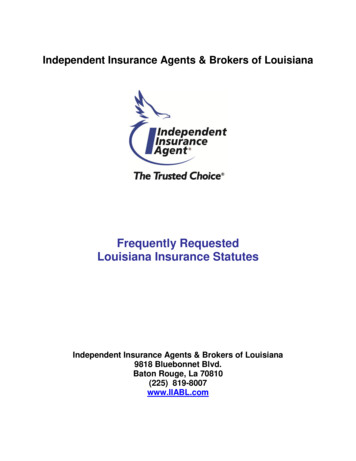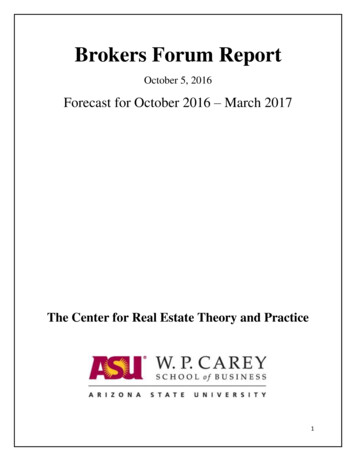
Transcription
Brokers Forum ReportOctober 5, 2016Forecast for October 2016 – March 2017The Center for Real Estate Theory and Practice1
ASU Commercial Brokers Forum SurveyForecast for October 2016 – March 2017Introduction“Work hard. And have patience. Because no matter who you are, you'regoing to get hurt in your career and you have to be patient to get throughthe injuries.”Randy JohnsonI think Randy Johnsons’ quote sums up where the metro commercial real estate market has beenand where it is now and how we should be dealing with the current and projected conditions. Wewere beat-up, we are working hard, and we need to be patient. This is not the economic recoverywe hoped for and as a result, adjustments in approach and attitude are needed. What the resultsof the current survey show is hard work and patience. In previous reports of survey results, wesaid that this is a slow and steady recovery and the results of the current survey show that trendcontinuing. A little uncertainty remains and appears to be heightened as evidenced by theresponse to the question “In what direction is the metro Phoenix market moving?” For 2 years100% of respondents said “up”. The current survey shows 88% believe the market is moving inan upward direction. Couple that response with response to the question “Where are we in thecycle?” where only 52% of respondents believed the market was in an expansion mode. It ispretty clear that uncertainty and a cautious attitude of respondents remains. We have a lot ofwork to do.When the results of the survey were discussed at the Forum, the participants continued to expressconfidence in the market when discussing long term outlook but there is a lack of absolute,unconditional confidence in the short term. Growth continues, projects are getting done and wecontinue to make progress as a metro area but in very specific product types and sub-markets.When discussing the market and survey results with Forum members, it is impossible to makecategorical observations unless it is prefaced with “It depends.” In fact, Forum members refer notto just sub-markets but to micro-markets – areas within sub-markets. This is as good anindication of the state of market as any –a very granular analysis is needed to understandpotential for any given product in any given sub-market. We are certainly not over building andpossibly we are in equilibrium – developing only what is needed to keep the market stable. Thiswas the case with the last Forum. When you look at the trends, and read the comments of Forummembers, the conclusion is clear that we are on pretty solid ground but outside factors aremaking it difficult for metro Phoenix to expand at a more robust rate and that is creatinguncertainty about the next six months. Concerns still exist and the geography of the expansion isstill not uniform – some products and submarkets are doing much better than others, and demandneeded to push opportunity for expansion to all submarkets is not certain and so we have beenslower to recover.BackgroundThe Forum has now been held for 3 consecutive years (eight separate surveys). It was first heldin October 2013. This report includes results of a survey conducted in late September 2016 and a2
discussion with Forum members held on October 5, 2016 about those survey results. The Forumis composed of 15 of the Valley’s most successful commercial real estate brokers representing allmajor product types, brought together by the W. P. Carey School of Business and the Center forReal Estate Theory and Practice with the assistance of Pete Bolton, Managing Director ofNewmark, Grubb, Knight, Frank. The purpose of the Forum is to provide meaningful, insightfuland relevant input on the commercial real estate market in Phoenix. The Forum members camefrom a variety of sectors and specializations as well as a cross section of the many brokeragehouses in the Valley. The Center for Real Estate Theory and Practice conducts the survey andbrings together the Forum every six (6) months to discuss and track the perceptions, insights andtrends in the Phoenix commercial real estate market.Previously, only Forum members were surveyed and the discussion was with those surveyed. Wewanted to expand the survey to get more respondents and thus more reliable results. For thisreport the survey was sent to more than 400 commercial brokers and sales agents working inthe metro Phoenix market. The results of this report represent response of 116 of those who wereasked to complete the survey. The Forum members met and discussed those survey results.The purpose of this forum is not only to seek informed opinion but to hopefully achieveconsensus on forward-looking key indicators of the commercial real estate market in the Phoenixmetropolitan area. The Forum is an open discussion about the survey results and what ishappening “on the street” in commercial real estate. The combination of the survey results andthe discussion with Forum members is used to detect current trends, discover similarities anddifferences among various sectors and submarkets and document anecdotal evidence, opinionsand insights. This report is a summary of their opinions. Each session builds on previous surveysand the information gathered is synthesized chronologically to provide an indication of trends.This is the eighth report of the Commercial Real Estate Broker Survey which addresses what thepanelists believe will happen between October 2016 and March 2017. The following chartsindicate the survey results and the Forum discussion. What you will see in this report are surveyresults and some key comments about the results by Forum members. The responses areanonymous. This is done so the panel members feel comfortable providing unbridled opinions.Reading the comments will give readers a sense of what these important players in thecommercial markets are thinking. Readers should note that the comments are those of thebrokers and are as close as possible to being verbatim. This is not a refined analysis of marketconditions.It is clear from the results of this edition of the Forum that those who know this market best arestill feeling slightly uncertain about where we are but remain confident the metro area willcontinue to expand in the long term. Uncertainty about the next six months remains in the backof our Forum members minds. So, if there is a pattern, it is continued uncertainty and concernabout continued significant expansion of the market. In our last report we asked the rhetoricalquestion: “Will the uncertainty in the federal government have a negative impact on the market?”and suggested that if it does, it will not be profound, rather it would be a slight pause. I think wecan say, based on most recent survey results and comments by Forum members that the markethasn’t fully paused but is shuffling along. Most all economic fundamentals suggest continuedrecovery and growth – but still only in certain micro-markets in certain submarkets.3
Many of the same systemic problems that have persisted for the past several years still exist tosome degree in some submarkets - attracting more high-wage earning jobs, construction laborshortages are still a problem but construction hiring is increasing, tight lending is still makinganything other than institutional grade borrowing tough and continues to keep a governor on newconstruction. They all wished for more activity in most segments, but see the progress. How weare growing is different from before the recession and continues to reflect a maturing metrodevelopment pattern. We want a faster, more robust expansion. We hope for more and fastergrowth. We are known for being a “boom and bust” market. Maybe what’s happening is we aregrowing up and this is a more sustainable pattern.These are the forward-looking opinions of the professionals who are in the market every day andknow it best. These survey results are their opinions based upon their experience.Mark StappExecutive Director, Master of Real Estate DevelopmentDirector, Center for Real Estate Theory and PracticeFred E. Taylor Professor of Real Estate4
Below are consensus statements made by the panel and charts that show responses to questionsasked of the Forum members. For most questions, Forum members could choose “Up”, “Down”or “Stationary”. For simplicity sake, we chose to only show % of respondents selecting “Up” butbelieve this adequately show trends.THE MARKET OVERALLCONSENSUS STATEMENTS on the overall market in Metro Phoenix: We are seeing expansion, but we are not seeing like we used to see it.The last time we all got together, we were at 71% who saw the cycle in expansion mode,and now with a far larger population, we have dropped to 52 percent, so half of us thinkwe are in an expansion, and the rest of us think we are going in a different direction.In our world, the job skills have totally changed; it is not just call center jobs anymore. Itis financial services for IT, cybersecurity, risk mitigation. There are a lot of thosebusinesses looking at Phoenix right now. There are specific skills needed in themarketplace today, and so corporate clients are looking to where those skills can befound.You might be able to develop a customer service center in some place like McAllen, TX,but you are not going to get the employee talent pool there that you need. We have laboravailable from ASU, U of A, NAU and Grand Canyon University. Phoenix has a bigadvantage right now with the number of graduates it produces and the people required tofill and sustain the labor needs of these target companies.Expansion is happening here and it is going to continue for at least a couple more years.Generally, the sentiment is that we have been out of the recession since at least 2011.Everyone is looking at what is going to happen a little bit later in this decade, like 2018.We are probably going to go into another slight recession, but nothing like we have beenin before.5
Where are we in the 1610/2016In what direction is the metro Phoenix market %10/201388%27%01/201404/201410/201410/20166
Will the number of people who have stopped working or stopped looking for work affectcommercial real estate 543%27%29%10/201504/201610/2016Are local economic development programs and the real estate markets 20167
Is uncertainty in the federal government affecting the commercial real estate market andhindering our local growth /201510/201504/201610/2016How will changes in Federal regulations related to commercial real estate lendingaffect themarket over the next 6 7%10/20168
Where are interest rates for commercial loans headed in the next six 0/201504/201610/2016Where are investor returns headed in the next six /201504/201610/20169
Has cap rate compression helped effect gains in core real estate values over the past sixmonths (April 2016 – September 510/201504/201610/2016Will cap rate compression continue in the next 6 months (October 2016 – March 510/201504/201610/201610
What is the overall feeling about the metro Phoenix commercial real estate /201510/201504/201610/2016OFFICE MARKETCONSENSUS STATEMENTS: If you need 100,000 square feet office space with parking at 6 stalls per 1,000 SF ofbuilding, there are 37 options south of the airport right, and that is new construction. Thatis conversion from industrial to office space. Very competitive. I think the strategy needs to start changing a little bit, land the deal, maybe ratchet downthe euphoria from an expectation of high teen net rents to something more realistic in the 14 to 15 range. No one has done that yet, but I think that is coming. There is tenantdemand, but there are so many options that rate expectations are going to need to beadjusted downward. We are going to see vacancy rates increase slightly with all the new product that hascome online. There is a great deal of construction taking place right now, and there maynot be the momentum to backfill a lot of it immediatly. The market is good, but there is alot coming online right now. We are all about micro markets right now. Example, Tempe is a hot market, but there arecertain parts of Tempe that are just on fire, and certain parts of Tempe that will neverlease. There are certain parts of North Central Avenue that are absolutely on fire, andthere are certain parts that will never lease. We are seeing a large number of companies from urban California into Phoenix.11
The movement from CA is mostly coming out of the Bay area. They love Phoenix. Theylove the labor force here because it is educated, and because they do not have to competeagainst Google or Facebook where they are losing employees right and left when theystay in the Bay area. They are coming here needing 8,000 square feet with capacity to goto 30,000 square feet. We have to negotiate the option to expand, with the potential to goto 30,000 square feet within three years.We are going see a whole lot of companies continuing to flow over here because ourenvironment is more conducive to their bottom lines.In San Francisco, rents are 85 per square foot, and they come to Camelback Corridorand take 40,000 square feet in a building and they are willing to pay 32 per square foot.It is a deal. They think, wow, what a savings we have.Downtown LA is the same as San Francisco. Rents are 60, 80 bucks a square foot now.It is always a tenant's market in Phoenix, Arizona.We need to grow organically. We are growing externally, which is just phenomenal. Wehave companies moving from other areas of the country.There continues to be a lack of consumer confidence, the 5,000 to 10,000 square footmom and pop regional companies, that really benefit the rent roll, do not beleive theeconomy is back, so business expansion is slow due to a lack of confidence.Where are office vacancy rates headed in the next six 4/20165%10/201612
Where are Class A office vacancy rates headed in the next six 16Where are Class B office vacancy rates headed in the next six 1613
Where are Class C office vacancy rates headed in the next six 16Where are office rents headed in the next six 10/201404/201510/201514
Where are Class A office rents headed in the next six 16Where are Class B office rents headed in the next six 1615
Where are Class C office rents headed in the next six 16Is this a tenant or landlord office 0/201616
Will we see more Office Spec Development in the next 6 016How will the amount of available shadow space change in the next 6 %10/201617
INDUSTRIAL MARKETCONSENSUS STATEMENTS: Industrial is still very, very strong, and part of that is rollover cost. It is a safer area toinvest in than office. Industrial is perceived as less risky. Office will kill you. Office is atiming game. We talked about industrial in Phoenix as it relates to jobs. We are seeing quite a bit moreexpansion locally from companies that are coming in from out of town, especially fromCalifornia with the minimum wage issue. A lot of our industry is impacted by blue collar jobs and the more that other states areraising the minimum wage, the more we benefit from that. We absorbed three million square feet in the first two quarters, so we were very hot andheavy last quarter, and we are due to be just as bullish in the third quarter according tosome of the speculative numbers. Historically, we have always been a boom and bust economy, and it has always beenbrought on by housing, as everyone knows. This time, we are recovering without housingand with a lot of manufacturing, which is great. I think the general consensus is that we have a longer runway than most other markets interms of industrial. Our recovery is going to hopefully be longer and stronger, but havingsaid all that, there certainly is plenty of space still available. You know that the market isnot great when the broker incentive e-mails are popping up again. We have to coach our developer clients all the time that, 10 percent vacancy is actuallypretty good. If you are from California and you are used to 4 or 5 percent vacancy, youare not going see that here. Ten percent is when people build. I believe in the last two years along the 303, all the manufacturing facilities that are beingbuilt are build to suits, not spec. I find that very interesting. I do not think we have everseen so many manufacturing and distribution manufacturing companies come into thisarea and build these big facilities. That tells us a lot about California and the inlandempire. I would say rail is back. There will be four or five rail deals that get done this year for thefirst time in a while. We finally started to see some good absorption here in the last 12 to 18 months. We haveseen quite a few big deals get done. We still have 13 buildings over 200,000 feet that aresitting vacant and are ready to go. I do not understand why someone builds another one,but they have the money, and so they do it. I think the demand has come up quite a bit, and we are actually seeing deals get done. Wehad six in the second quarter over 250,000 square feet. That is a pretty big number. They can always get out of it, right? If a developer builds a building for 42 a squarefoot, he can sell it to an institutional buyer for 48. He puts a tenant in there, caps it andsells it for 65. As long as you build the right institutional type product, you can alwaysget out of it.18
In retail, you start negotiating, and you figure out there is going be a little give here andthere. Industrial buyers must have patient money because they do not give on anything. Itmakes me think that whoever is developing these buildings has enough cash. They arepatient, and can just wait for the right people to come along.Where are big box industrial vacancy rates headed in the next six 1504/201614%10/2016Where are big box industrial rents headed in the next six 04/201627%10/201619
Is this a tenant or landlord industrial 557%04/201610/2016Will we see considerable Spec Development in the industrial market over the next 201620
RETAIL MARKETCONSENSUS STATEMENTS: Going back to the investment part of the discussion a little bit, there is hardly any smalldecent retail product because of the Mom and Pops coming out of trades. There is almost no new construction; there are about eight new shopping centers withactual Sprouts or Fry's as tenants. Safeway is actually going to be doing a new deal,which was a surprise, but they are not building as many square feet of shops, and it isexpensive. There is just nobody to fill the space anymore because everything that we have now iseither health and wellness, restaurants, or medical. Even if you are on Scottsdale Road—even with that, you are losing tenants almostimmediately because somebody who is not serving liquor cannot pay 42.00 a foot triplenet and make it. That was a real lesson to be learned as far as how far you can stretchbecause everybody gets all caught up in the energy, and they think, I have to be there.Then they can't make any money. One thing that is happening this year that has not really happened in the past in the retailcategory is that the retailers are out trying to hire now for Christmas, and this is reallyearly for them to try to be hiring now. They think there is going be a shortage in the laborpool, so it is the part time labor pool that they are after, so that is why they are going afterit earlier. We have so many retail bankruptcies, and now it is really starting to happen in the foodbusiness as well. There has been six food restaurant bankruptcies filed in the last tendays, and there is going be more, so vacancy rates are going to go up. Restaurants are the ones that have been driving the rents. But, there are only so manypizza places, so many hamburger joints that can survive. Sports Chalet is gone. Sports Authority is gone. Golfsmith has filed bankruptcy. Dick's isgoing be the winner in that category. They bid on 31 stores throughout the country, onlyone of which is here in Arizona. There are 243 spaces available over 10,000 square feet, somewhere in that range. It nevergets better. It is like two steps forward, one step back. One of the big problems with owners dealing with some of this vacant space is theunderlying CC&Rs that exist for shopping centers where alternative uses are not allowedwithout the approval of the other major tenants. The negotiations can be tough.21
Where are retail vacancy rates headed in the next six 150%04/201610/2016Where are retail — anchored center rents headed in the next six 410/201504/201610/201622
Where are retail - unanchored center rents headed in the next six /201504/201610/2016Where are retail — big box (over 25K square feet) rents headed in the next 6 521%04/201610/201623
Is this a tenant or landlord retail 01504/201675%10/2016Will we see an increase/decrease in Big Box Absorption over the next 6 %10/201624
MULTIFAMILY MARKETCONSENSUS STATEMENTS: Class A rents continue to climb and go up at a steady trajectory. From the end of 2015 to second quarter 2016, rents jumped 12 percent on the A’s, almost 130.00 per unit per month. It seems like there is still an insatiable demand for Class A product. The Class B productis seeing a little bit less increase at 8 percent jump, and the Class C product is stilllagging in the marketplace at about 6 percent jump in rents over the last eight, ninemonths. Construction has continued to pace about 5,000 to 6,000 units a year. Right now as wespeak, we have just over 9,000 units coming out of the ground. Phoenix has seen thegreatest number of developer of properties, 69 in the last five years, followed by Tempe. In our office we rank brokers every month to identify the top 15 brokers in the company.For the last two years, it has been multifamily, multifamily, multifamily, multifamily. I think that we are still very strong in multifamily. This quarter has been a little quieterthan the fourth quarter of last year, and that is because the market flooded last year in thefourth quarter, so I think everybody learned a lesson. Although it is a little quieter thanlast quarter, there is still a huge amount of activity. I am not feeling the pullback. Inventory blew up in May and June. We had 120 listings in the marketplace. It has comedown to 84. One thing tha has been interesting, in the fourth quarter right after LaborDay, we usually see a big push to get product to go on market, and we have only seen 10or 11 listings hit the market in the last three weeks. Inventory is starting to contract a littlebit, and we are not seeing as many sellers go to market. I think a lot of owners are saying,hey, I think there is still more runway in multifamily, and I am going to hunker down andraise rent some more and add value. Debt is still cheap. There is still an abundance ofbuyers. Rents just keep moving up. They will just keep raising the rent, so you are going havevacancy. We have been adding apartments, but it is in very specific places. Those are downtownPhoenix, Tempe, south Scottsdale, and then you have activity going more northScottsdale, and then you have activity on 16th Street and 7th Street, and that is it. Theyare all building in one spot. There are speckles in Chandler. We are starting to see someplanned west of 17, but there has been nothing west of 17. I think the development feels really healthy, but I also think there is saturation in certainpockets that is going take some time to deal with, and those guys just need to ride it out.Those sub-markets will see vacancy, and we will see a little bit of a concession offeredrenters in these areas. There are different product types, urban podium style, which wehave not built before.25
I think Tempe is going to see some softness, maybe south Scottsdale, but central—downtown Phoenix, Central Corridor, you cannot build enough units, there is so muchdemand in that market.The availability of skilled labor is definitley a concern. There is a 12 acre site undercontract in Flagstaff, they are going to ship all the labor up there from Phoenix becausethere is not enough in Flagstaff.The real problem with this is, if you are building something out of the city, MaricopaCounty, you literally have to pay the workers to go there. You have to pay for their gas togo up and come back. "Then they will show up?" "No, not necessarily." If they have adifferent offer from somebody, even though they told you they would go there, they donot show up. They stay somewhere else.Which multifamily property class will realize the greatest rent growth in the next sixmonths? If anybody can figure this out, give me a holler.I do not know if you guys have noticed, but we have tried to get a TI bid now. They areridiculous. For medical, 90 a square foot for basic, basic medical. It is because the subsare charging through the nose because they can not get enough subs, and so everything isgoing up. The landlords are freaking. The tenants are freaking.The cost of construction is crazy. I can't remember the guy I was talking to the other day,but he said that, he was out on one of their sites, and he asked for the head masonry guyto come over to ask why is he having problems with his crew? The head of the crewcame over and he was 62 years old, and the average age of his crew was in the 40s.The average age of plumbers right now, is 47 or something like that – there is a shortageand those we have are on older side.Where are apartment vacancy rates headed in the next six 20150%04/201610/201626
Where are Class A apartment vacancy rates headed in the next six 16Where are Class B apartment vacancy rates headed in the next six 1627
Where are Class C apartment vacancy rates headed in the next six 16Where are apartment rents headed in the next six 201543%04/201610/201628
Where are Class A apartment rents headed in the next six 16Where are Class B apartment rents headed in the next six 1629
Where are Class C apartment rents headed in the next six 16Which multifamily property class will realize the greatest rent growth over the next sixmonths (October 2015 – March 2016)?PROPERTY 25%71%58%57%33%36%8%9%10/201404/20150%04/2014Class AClass B0%10/20157%04/201629%0%10/2016Class C30
Have apartment rents for newly constructed projects reached their peak given the currentmarket 10/2016Will the availability of labor be an issue in the development of Aprtment porjects over thenext 6 201631
How much has the cost of materials impacted rental 0%29%10/2016Will apartment affordability be a concern over the next 6 01632
LAND/HOUSING MARKETCONSENSUS STATEMENTS: We have always said Phoenix, in
confidence in the market when discussing long term outlook but there is a lack of absolute, unconditional confidence in the short term. Growth continues, projects are getting done and we . cybersecurity, risk mitigation. There are a lot of those . 10/2013 01/2014 04/2014 10/2014 04/2015 10/2015 04/2016 10/2016 EXPANSION 33% 73% 27% 84% 100% .
